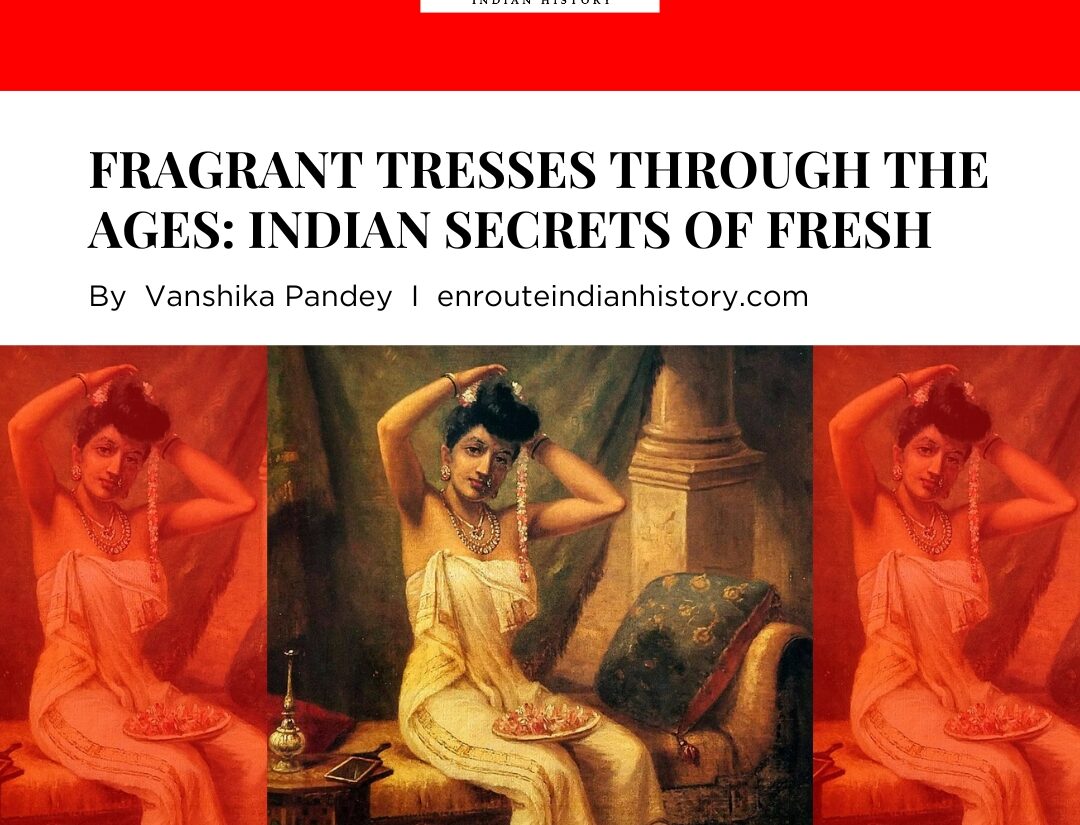Fragrant Tresses Through the Ages: Indian Secrets of Fresh Vanshika
- EIH User
- July 26, 2024

Fragrant Tresses Through the Ages: Indian Secrets of Fresh Smelling Hair

One method that has been used since ancient times till date is hair oiling with fragrant like jasmine oil is one such example, it is a staple in every Indian household, popularly called Chameli ka Tel. The use of jasmine oil can be traced back to ancient India, where it was a staple in Ayurvedic medicine. Ancient texts describe jasmine as having soothing, cooling, and healing properties that nourished the scalp, promoted hair growth, and imparted a pleasant fragrance. Even coconut and almond oils were used in hair to impart a sweet peculiar scent.
In India, herbs like amla, brahmi, shikakai, and henna have been traditionally used for their hair health benefits and natural fragrances. Amla, rich in vitamin C, promotes hair growth and adds a subtle earthy scent. Shikakai, known as “fruit for the hair,” has been used for centuries as a natural shampoo, offering a distinct, woody aroma. Henna, famous for its hair coloring and conditioning properties, provides an earthy, herbal scent and can be enhanced with essential oils like lavender or jasmine. These herbs are often combined to create custom hair care treatments, such as mixing amla, brahmi, and shikakai powders with water for a nourishing mask or adding essential oils to henna paste for a fragrant dye. Their modern usage continues in both traditional and commercial hair care products, reflecting the enduring appeal of these natural, aromatic solutions in Indian hair care practices. These herbs not only improve hair health but also provide a connection to India’s rich heritage of natural beauty treatments.
Flower-infused hair rinses have long been celebrated for their natural, aromatic benefits. Rose water, used since the Mughal era, is prized for its sweet fragrance that enhances the hair’s natural scent. Hibiscus water, made by boiling hibiscus flowers, adds a subtle floral aroma while conditioning the hair. Mogra (jasmine) water, prepared by soaking jasmine flowers, imparts a rich, luxurious fragrance to the hair. These infusions are crafted by steeping or boiling the flowers and are used as a final rinse to impart delightful, natural scents to the hair. Traditionally cherished for their aromatic qualities, these floral rinses remain popular in ancient and modern hair care routines, offering a natural and refreshing way to enhance hair fragrance, and not just flowers, even fruits like lemons have been used extensively in the Indian hair care routine, Lemon juice mixed with water acts as a natural deodorizer and leave hair smelling citrusy fresh when rinsed with it.
The tradition of using flowers as a scent for hair does not stop at flower rise, gajras and phool are an important part of it, the tradition of adorning hair with flowers is deeply rooted in cultural history, symbolizing beauty and regional identity. Gajra, a garland often made from jasmine and sometimes roses or marigolds, has been used for centuries during festivals, weddings, and celebrations. The jasmine’s sweet fragrance is particularly cherished. In India, the tradition of adorning hair with flowers has deep historical roots, serving not only as a means of personal beautification but also to add a natural floral scent to the hair. The use of gajra, a garland of flowers typically made from jasmine (mogra) and often intertwined with roses or marigolds, is a practice that dates back centuries. Women across various regions of India have used gajras to adorn their hair, especially during festivals, weddings, and other significant celebrations. The sweet, intoxicating fragrance of jasmine in the gajra is particularly favored for its association with beauty and sensuality. In South India, especially in Tamil Nadu and Kerala, the tradition of wearing flowers in the hair is an everyday practice. Women often tuck strings of jasmine, known as malligai, into their braids or buns, filling the air with a delightful aroma. This practice is not only a mark of cultural identity but also a daily ritual that celebrates the natural beauty and fragrance of flowers. During significant festivals like Pongal and Onam, the use of flowers becomes even more elaborate, with intricate designs and abundant garlands adorning women’s hair. In Maharashtra, gajras made from the buds of mogra are particularly popular, with their delicate white flowers symbolizing purity and elegance and freshness. In the northern states of India, like Uttar Pradesh and Rajasthan, women often use marigold flowers to create vibrant, fragrant hairpieces. The bright orange and yellow hues of marigold garlands are a common sight during festivals like Diwali and Navratri, where they are used to signify prosperity and festivity. In Bengal, women wear flowers such as tuberose (rajanigandha) and lotus in their hair, especially during Durga Puja.
Beyond gajras, tucking a single flower behind the ear or into a bun is a widespread custom across India. This simple act transforms the ordinary into the extraordinary, adding elegance and fragrance to daily life. Flowers like lily, daisy, and roses are commonly used, each bringing its unique scent and symbolism. The practice of wearing flowers in hair is not just about adornment but also a sensory connection to nature and tradition, a living testament to India’s rich cultural heritage and the timeless beauty of floral fragrances.
Hair perfuming has been a significant aspect of royal rituals in India. The beauty routines of women, especially those from affluent or royal backgrounds, were equally elaborate, if not more so, than their male counterparts. Indian women of the time would perfume their hair with fragrant oils or by drying it over burning incense, a practice also mentioned in Kalidas’s ‘Meghduta’. Perfumery developed into an art form and the perfume consumption in India peaked during the Mughal era, where emperors and courtiers, known for their refined tastes, elevated the tradition to a high art.
One notable historical figure associated with luxurious grooming rituals is Rani Padmini, the legendary queen of Chittor in Rajasthan. The queen is often depicted in folklore and literature as an epitome of beauty and grace, adorned with fragrant oils and exquisite jewelry. Her story symbolizes the ideals of beauty and royalty in Indian culture. It’s conceivable that she, like other queens of her time, indulged in hair perfuming rituals as part of her grooming regimen. Bakhoor, a traditional incense, holds a cherished place in ancient Indian traditions, especially in hair perfuming. It is a fragrant blend of aromatic woods, resins, and spices. When burned, it releases aromatic smoke that envelops the hair, infusing it with a luxurious fragrance. Royal baths, weddings, and other auspicious occasions often featured the indulgent use of Bakhoor. Moreover, these natural ingredients are known for their nourishing and rejuvenating properties, making Bakhoor more than just a fragrance—it embodies a holistic approach to hair care and sensory indulgence, rooted in centuries-old royal traditions. Even the movie Jodha Akbar depicts a scene where Jodha Bai’s hair were smoked by incense sticks, which served the dual purpose of drying the hair and imparting fragrance in them.
- Ancient Indian hair care tips
- Best flowers for hair fragrance
- Floral hair care remedies
- Fresh hair scent with natural ingredients
- Fresh smelling hair tips
- Hair fragrance with natural ingredients
- Indian cosmetic secrets for hair
- Indian hair care secrets
- Natural hair fragrance ideas
- Natural hair perfumes for daily use
- Traditional hair perfumes of India


















